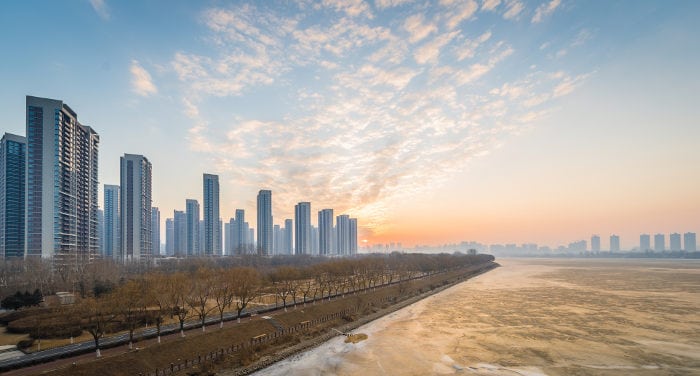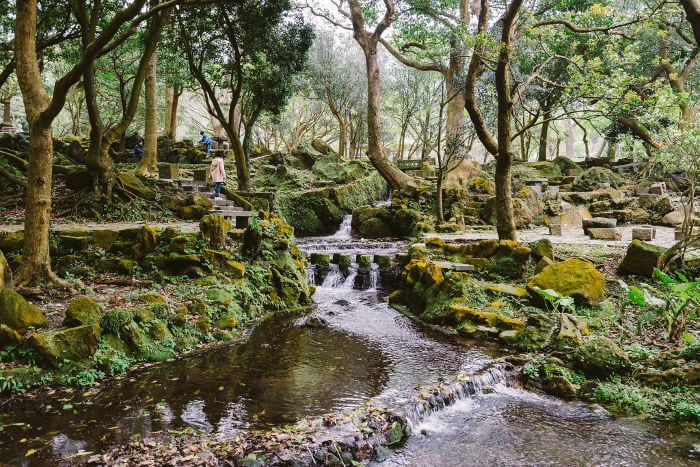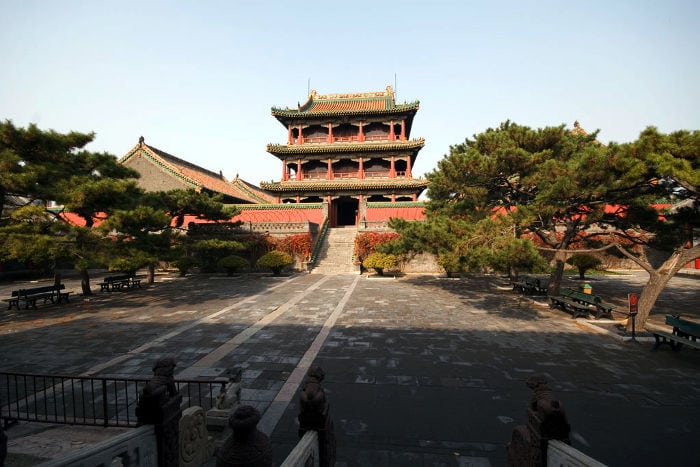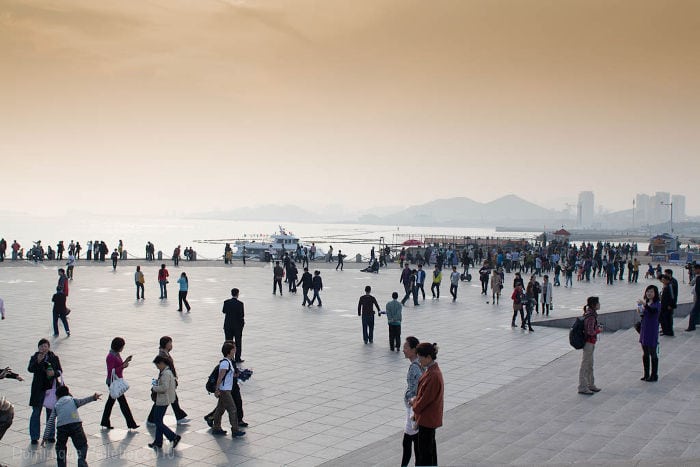
![]() Sun Rise on River in Shenyang by Aaron Sorrell
Sun Rise on River in Shenyang by Aaron Sorrell
Liaoning Province is often referred to as the Golden Triangle due to its geographical location which borders the Bohai Gulf, the Yellow Sea and, of course, North Korea.
Its proximity to the coast means that Liaoning serves as a logistical and economic gateway to Northern China as well as the Korean peninsula. The province’s recorded history can be traced all the way back to 1600 BC when it was part of the Shang Dynasty. However, there is also evidence to suggest that early communities existed in Liaoning more than 5000 years ago.
In this guide you will find information about:
- How to reach Liaoning Province;
- The best time to go there;
- The city of Shenyang;
- The Strange Slope Scenic Area;
- The city of Dalian;
- The city of Dandong;
- Qianshan National Park;
How to get to Liaoning Province
The fastest and most efficient way of getting to Liaoning is by plane. Flights to Shenyang Taoxian International Airport and Dalian Zhoushuizi International Airport are available from Beijing, Shanghai and many other Chinese cities.
If you wish to see more of China up close and perhaps have a more charming experience, consider travelling by train. You can get a train to Shenyang or Dalian, the two most important cities of the province, from Beijing, Shanghai and many other cities. Train ticket options vary but be wary of opting for a standing ticket; although extremely affordable, standing on a Chinese train for 12 hours can be a rather grueling experience.
When to go to Liaoning Province
The best time to go to Liaoning Province depends on you. Liaoning in the summer is spectacular as the landscape is covered in every shade of green you could ever imagine, but can be uncomfortable at times due to the humidity. At the same time, Liaoning is famous for its various winter festivals and the snowy scenery will prove to be just as unforgettable.
The City of Shenyang
Home to no less than two UNESCO World Heritage sites, Shenyang serves as the provincial and economic capital of Liaoning Province. The city has been host to events that have shaped history on a number of occasions. Nurhachi, the 1st Emperor and founder of the Qing Dynasty built his first Imperial Palace in Shenyang. In 1931 the Huanggutun incident took place, which resulted in war being declared between China and the Empire of Japan. This eventually led to the occupation and immense suffering of North Eastern China at the hands of the Japanese Empire.
The Qing Dynasty was founded in 1644 and lasted all the way until 1912 when it was succeeded by The Republic of China, making it the last of the great Chinese dynasties. The founder of the Qing Dynasty was a Jurchen chieftain known as Nurhachi.
The last ever founder of a Chinese Dynasty deemed Shenyang the most suitable place to construct his first Royal Palace. Second only to the Forbidden City in Beijing, Mukden Palace is an incredible example of traditional Chinese architecture and was finished in 1651. The vast complex features throne rooms with stunning dragon carvings, Chinese shrines and of course, an abundance of Concubine quarters.
To get to the Mukden Palace find bus number 213 or 222, the trip will cost you 1 Yuan. Alternately you can make your way to the Zhonge Jie metro stop on line 1; the palace is within walking distance from here.
Nurhachi, the founder of the Qing Dynasty liked the area surrounding Shenyang so much, not only did he construct his grand Imperial palace there, this was also the place he wished to be laid to rest. Fuling is the first Imperial tomb of the Qing Dynasty and serves as the final resting place for the founder of the last ever Chinese dynasty.
Much like the Mukden Palace, the tomb is a wonderful example of classical Chinese architecture with a heavy Manchu influence. The tomb is surrounded by a large park with a few lakes, well worth a look while you are in the area.
Before planning a trip to Fuling be sure to double check whether it is open or not as it is often closed during the winter season. To get to the tomb you will need to take bus number; 148, 168, 218 or 385 and get off at Donglinggongyuan (东陵公园, East Tomb Park).
A video of a bike “climbing the Strange Slope of Shenyang”
Strange Slope Scenic Area
Located approximately 30 Km outside the city of Shenyang, this is a place where the laws of physics do not apply, as it violates all that we know about gravity. The Strange Slope stretches for about 50 meters and its slope is very gradual. If a car stops at the foot of the slope it will defy gravity and roll towards the top of the slope with no difficulty.
The opposite occurs when you try and let a car roll down the slope; instead of rolling down with ease the opposite becomes true. To this day experts are still unable to fully explain this phenomenon but most claim that it comes about because of magnetic fields and optical illusions.
The slope is split into two sections, one for cars and the other for bicycles, so don’t worry if you do not have access to a car, you can still experience this bizarre phenomenon with your bicycle.
The actual slope area is just one aspect of the scenic area and the Strange Slope is not the only unusual physical phenomenon that you can experience here. About 100 meters away from the slope is Xiangshan, where if you stomp on the ground you are able to hear a loud and distinct sound resonating from the earth below.
This is apparent in the name of the hill, which means, “Mountain which produces a loud sound”. You may think that two “extraordinary” phenomenons would be enough for one area but you would be wrong. Located nearby is another hill known as Wongding. If you stomp on this hilltop a sound resembling a wooden hammer can be heard from the earth.
To get to the Strange Slope Scenic Area hop onto bus number 383 and get off at the Strange Slope stop. The journey will take you about half an hour and admission is 40 Yuan.
The City of Dalian
Dalian is the second largest city in Liaoning Province, after the capital Shenyang, and the largest port in northern China, as well as a major destination for Chinese tourists.
Dalian is a young city, by Chinese standards, as it was founded in 1898, though smaller settlements had long existed in the area. Its development stemmed from colonial occupation, in this case by Russia.
Within China, Dalian is famous for its many squares and green places scattered throughout the city, each with its own distinct character. There is Zhongshan Square, which hosts the city’s financial centre and some fine old Japanese buildings, Renmin Square, whicn boasts an impressive fountain, and Xinghai Square, which is the largest square in Asia and hosts the Dalian Beer Festival in late July and early August.
If you go to Dalian you can also visit some of the beaches near the city or Changxing Island, which is connected with the mainland through two bridges.
The City of Dandong
Only a few hundred meters separate this small but incredibly lively Chinese city from North Korea. Dandong’s proximity to the Korean peninsula means that the city is heavily influenced by Korean culture. Korean restaurants are peppered all over the city, offering a wide variety of delicious food such as dragon noodles and a multitude of chicken dishes, a few even offer the infamous ‘delicacy’ of dog meat (狗肉).
I didn’t have the stomach to even enter one of these particular establishments, so unfortunately I cannot tell you how much dog meat goes for but I was told it’s generally rather expensive.
By far the most interesting place to visit in Dandong is the Broken Bridge, which used to connect China to the reclusive Hermit Kingdom, before the US Army bombed the North Korean side of the bridge. The Chinese half of the bridge still stands today, as a symbol of, “The Defeat of American aggression”.
The contrast between the immense development of China and the exact opposite of North Korea is clearly visible from Broken Bridge; the hustle and bustle of a thriving Dandong on one side of the river and the eerie idleness of North Korea on the other.
If you want to have an even closer look at North Korea boat rides, which take you right up to the North Koran side of the river are available. This is the closest you will ever get to North Korea without actually having to enter the country.
Fascinating souvenirs can be bought from the many vendors around the Sino-Korean Friendship Bridge, which runs adjacent to the Broken Bridge; from North Korean currency to badges with the likeness of the North Korean leader Kim-Jong Il. Be sure to try your hand at bargaining as foreigners are seen as walking piggy banks to the cunning local vendors.
Nightlife across most of China is a truly fascinating phenomenon and Dandong is no different. During your time in the city you will be missing out on a lot of fun if you do not pay a visit to the bombardment of light that is True Love Club. Be warned though, True Love Club is known for making foreigners part of the night’s entertainment but participating leads to rewards, so don’t be shy!
You can get to Dandong by any choice of transportation offering but the best option is to book a ticket on the fast train from Shenyang, which is cheaper than flying as well as less of a hassle. The trip will take about 2.5 hours and a train ticket will cost you around 80 Yuan, depending on the time of year you choose to go.

![]() 前山公園 by Wei-Te Wong
前山公園 by Wei-Te Wong
Qianshan National Park
The Chinese are very good at naming places and Qianshan is no different, literally meaning, “a thousand mountains.” You may think that the name is a typical exaggeration but in fact it is very accurate. Qianshan National Park is made up of just under one thousand interweaving peaks and has everything a lover of nature could ever wish for: majestic mountains covered in green, winding hiking trails and awe-inspiring views.
Qianshan is a shortened version of the area’s original name, “Thousand lotus flower mountains,” because the people that named the area felt that the mountains resembled the petals of a lotus flower that had fallen to earth from heaven.
Dotted all across the national park are Buddhist temples and shrines which only add to the immense beauty and charm of the area. Some notable ones include; the Maitreya Buddha scenic spot, the largest naturally formed Buddha anywhere in the world. Spanning an impressive 70 meters you can get to the Maitreya Buddha in the comfort of a cable car or via a steep hiking path for the more adventurous types.
Nature enthusiasts should put aside 40 minutes to check out the Garden of Birds, an area containing more than 100 different species of birds. There is a local legend that one of the early emperors of the Tang Dynasty drank water from a spring located in Qianshan and found the water to be particularly sweet so he created the Dragon Spring Temple (龙泉寺). You can visit this temple today and drink from these famous springs, in total there are two springs; one bitter and one sweet.
The closest city to the Qianshan National Park is Anshan so you will need to make your way here before heading to the National Park. The best way to get to Anshan is by catching one of the frequent trains from Shenyang. The trip takes about 50 minutes and shouldn’t cost you more than 50 Yuan.
Conclusions
Liaoning has something for everybody: from the hive of activity that is contained within most rising modern cities of China with their tall skyscrapers and abundance of activity to the peace and tranquility that China’s national parks and scenic areas have to offer.





